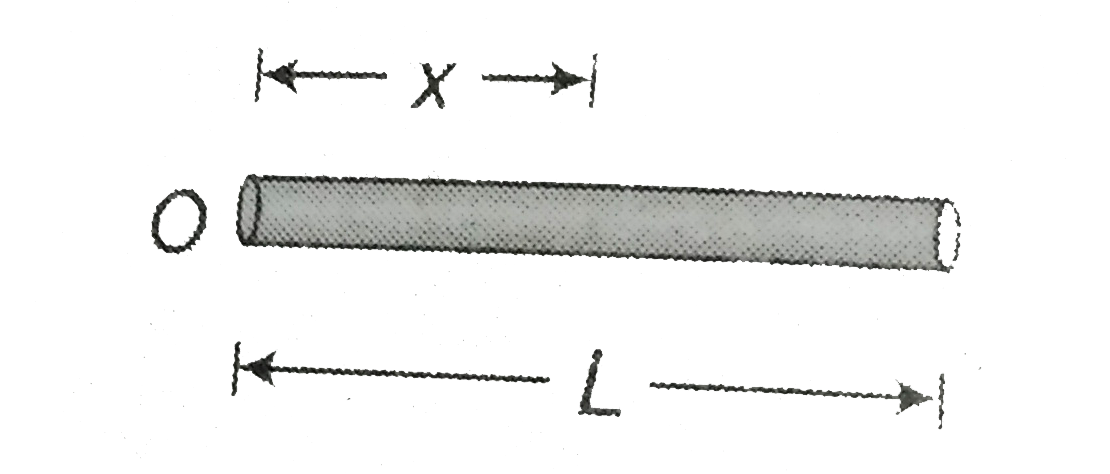The density of a linear rod of length L varies as ρ = A+Bx, where x is the distance from the left end. Locate the centre of mass.Solution in Bengali
The correct Answer is:xcm=3AL+2BL23(2A+BL)
Step by step video, text & image solution for The density of a linear rod of length L varies as rho = A+Bx, where x is the distance from the left end. Locate the centre of mass. by Physics experts to help you in doubts & scoring excellent marks in Class 11 exams.
Updated on:21/07/2023Topper's Solved these Questions
- STATICSBOOK - CHHAYA PUBLICATIONCHAPTER - STATICSEXERCISE - Problem Set -II (Based on Equilibrium of Force )
1 Videos
- STATICSBOOK - CHHAYA PUBLICATIONCHAPTER - STATICSEXERCISE - Problem Set -II (Based on Equilibrium of Body )
5 Videos
- STATICSBOOK - CHHAYA PUBLICATIONCHAPTER - STATICSEXERCISE - Problem Set -I (Based on Centre of Gravity )
2 Videos
- SIMPLE HARMONIC MOTIONBOOK - CHHAYA PUBLICATIONCHAPTER - SIMPLE HARMONIC MOTIONEXERCISE - CBSE SCANNER
16 Videos
- SUPERPOSITION OF WAVESBOOK - CHHAYA PUBLICATIONCHAPTER - SUPERPOSITION OF WAVESEXERCISE - CBSE Scanner
14 Videos
Similar Questions
Five masses 1 g, 2 g, 3 g, 4 g, and 5 g are suspended serially at a separation of 25 cm from a weightless metre rod. Where should the rod the be supported so that it remains horizontal?
View SolutionTo lift a motor car from a ditch, one end of a rope ABC is attached to a point A of a tree and the other end is tied at a point C of the car. At the mid-point B of the rope ,a pull of 200 kg -wt is applied at right angles to AC. If ∠ABC=120∘ , find the tension in the rope.
View SolutionA uniform straight rod mass 50 kg and length 4 m is to be supported on two supports equidistant from the respective ends. What can be the maximum distance of the supports so that a 30 kg counterpoising weight can be kept in equilibrium at any point on the rod?
View SolutionExplain the relation in phase between displacement velocity and acceleration in SHM, graphically as well as theoretically.
View SolutionA progressive wave is given by y(x,l)=Bcos(300t−0.15x) where x and y are in cm and t in second . What is the (i) direction of propagation, (ii) wavelength , (iii) frequency, (iv) wave speed and (v) phase difference between two points 0 . 2 m apart ?
View SolutionThe density of a linear rod of length L varies as ρ=A+Bx where x is the distance from the left end. Locate the centre of mass.

View SolutionA rod of length L is placed along the x-axis between x=0 and x=L . The linear mass density (mass/length) rho of the rod varies with the distance x from the origin as rho=a+bx . Here, a and b are constants. Find the position of centre of mass of this rod.
View SolutionIf the linear density (mass per unit length) of a rod of length 3m is proportional to x, where x, where x is the distance from one end of the rod, the distance of the centre of gravity of the rod from this end is.
View SolutionThe linear mass density i.e. mass per unit length of a rod of length L is given by ρ=ρ0(1+xL), where ρ0 is constant , x distance from the left end. Find the total mass of rod and locate c.m. from the left end.

View Solutionएक छड़ के पदार्थ का घनत्व ρ=A+Bx के अनुसार बदलता है , जहाँ A,B अचर है तथा x, छड़ में बाएँ किनारे से दूरी है | छड़ कि दूरी लम्बाई L है | इसके द्रव्यमान केंद्र कि स्थिति ज्ञात करें |

View SolutionL लम्बाई की रेखीय छड़ का घनत्व ρ=Bx से बदलता है जहां x बाएं सिरे से दूरी है। छड़ का द्रव्यमान केंद्र है
View SolutionIf L is the linear density of the length rod. lamda = A + Bx Calculate the position of the center of mass. (Where x is the distance from one end)
View SolutionA rod of length L is placed along the X-axis between x=0andx=L. The linear density (mass/length) ρ of the rod varies with the distance x from the origin as ρ=a+bx. a.) Find the SI units of a and b b.) Find the mass of the rod in terms of a,b, and L.
View SolutionThe density of a rod of length L varies as ρ=A+Bx where x is the distance from the left end. Locate the centre of mass.

View SolutionIf the linear density of a rod of length L varies as lambda = (kx^(2))/(L) where k is a constant and x is the distance of any point from one end, then find the distance of centre of mass from the end at x = 0.
View Solution
